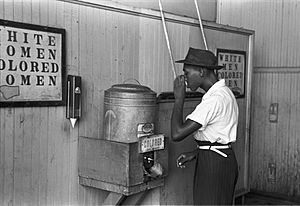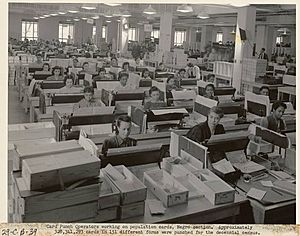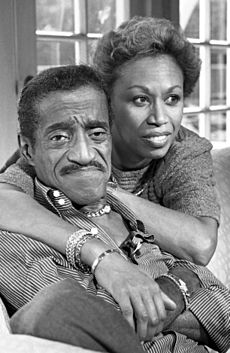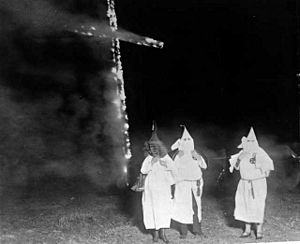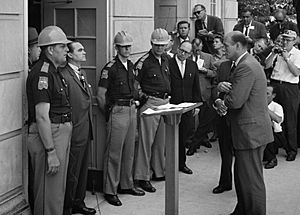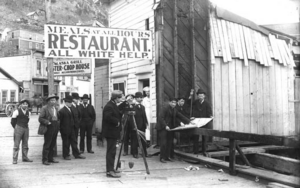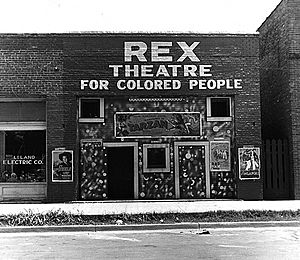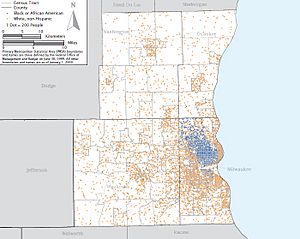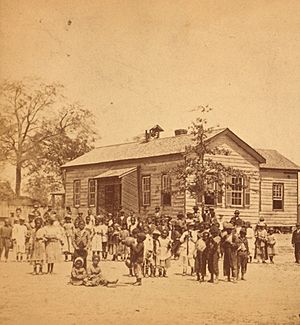Racial segregation in the United States facts for kids
Racial segregation in the United States means keeping people apart based on their race. This often involved separating facilities and services like homes, schools, hospitals, jobs, and transportation. Most often, it referred to the forced separation of African Americans from white people. It also included rules against people of different races marrying each other.
For a long time, signs showed where African Americans could legally walk, drink, rest, or eat. The U.S. Supreme Court said segregation was okay in 1896, as long as facilities were "separate but equal." However, in reality, facilities for African Americans were almost always worse. In 1954, the Supreme Court decided that "separate but equal" was not fair for public schools. Later, laws like the Civil Rights Act of 1964 helped end these segregation rules.
There were two main types of segregation:
- De jure segregation: This was segregation required by law. It was used before the Civil War with slave codes and after the war with "Black Codes" and "Jim Crow laws." These laws were made illegal by the Civil Rights Act of 1964 and other laws.
- De facto segregation: This means segregation that happens in real life, even without specific laws. It continues today in areas like where people live and which schools they attend, often because of past laws and ongoing social patterns.
Contents
History of Segregation
After the Civil War
After the Civil War, during a time called the Reconstruction Era, the government tried to give African Americans more rights. In 1870, the Fifteenth Amendment gave African Americans the right to vote. A law in 1875 tried to stop racial segregation in public places. Federal troops in the South helped make sure black people could vote and elect leaders.
New public schools were created in the South, mostly for white and black children separately. African Americans wanted schools for their children but did not usually ask for schools where both races learned together. After federal troops left in 1877, new laws called "Jim Crow laws" started to enforce segregation. Black people also began to lose their right to vote. By 1910, segregation was very strong across the South.
The Jim Crow Era
In 1896, the U.S. Supreme Court case Plessy v. Ferguson said that laws requiring "separate but equal" facilities for black and white people were legal. This decision made segregation common in the Southern United States. Public services like schools, hospitals, and even movie theaters had separate sections for each race. However, the services for African Americans were almost always of lower quality. For example, black schools received much less money than white schools.
In the Northern states, segregation was not required by law, but it often happened anyway. Many black students attended schools that were almost entirely black.
President Woodrow Wilson, who was from the South, started separating federal workplaces by race in 1913.
The "separate but equal" rule was a big focus of the Civil Rights Movement. In 1954, the Supreme Court case Brown v. Board of Education made segregated public schools illegal. The Civil Rights Act of 1964 later made all state and local laws requiring segregation illegal.
The New Deal and World War II
The "New Deal" programs in the 1930s, which aimed to help people during the Great Depression, were also segregated. Black and white people rarely worked together in these programs. For example, the Civilian Conservation Corps (CCC) camps were mostly separated by race.
Even so, the New Deal brought some benefits to black communities. This led many African Americans to support the Democratic Party. President Franklin D. Roosevelt issued an order in 1941 that was the first federal rule against discrimination in jobs. Later, President Harry S. Truman ordered the desegregation of the federal government and the armed forces in 1948.
In World War I and World War II, black soldiers served in separate military units. They often had less training and worse equipment. The U.S. military was still largely segregated in World War II. Black soldiers sometimes even had to give up their seats on trains to Nazi prisoners of war. However, World War II also saw the first black military pilots, the Tuskegee Airmen. Officer training schools began to integrate black and white soldiers in 1942.
After World War II, more people pushed for an end to segregation in the government. President Harry S. Truman signed an order in 1948 that ended segregation in the United States Armed Forces.
During World War II, many people of Japanese descent were placed in internment camps. While this was a different type of segregation, it showed how the government could separate groups of people.
Even famous black entertainers faced segregation. Hattie McDaniel, the first black Oscar winner, was not allowed to attend the premiere of Gone with the Wind in Atlanta because of segregation. At the Academy Awards ceremony, she had to sit at a separate table.
Segregation in Daily Life
For much of the 20th century, many white people believed that black neighbors would lower property values. The government offered low-interest home loans, but black families were often denied these loans if they lived in "areas in decline," which were often black neighborhoods. The government also built highways through black neighborhoods, destroying homes and forcing families into public housing projects.
President Woodrow Wilson did not stop segregation in federal offices. White and black people were often required to eat separately, go to separate schools, and use separate public facilities like restrooms and water fountains.
A key moment against segregation happened in December 1955 in Montgomery, Alabama. Rosa Parks refused to give up her bus seat to a white passenger. Her brave act sparked the Montgomery bus boycott, a major event in the Civil Rights Movement.
Segregation was also common in housing. Some state laws tried to control where people of certain races could live. In 1917, the Supreme Court said these laws were unconstitutional. But then, white property owners used "restrictive covenants," which were agreements not to sell homes to black people. In 1948, the Supreme Court ruled that these agreements could not be enforced in court. However, by then, segregated housing patterns were already set in many cities.
When African Americans moved into cities, especially during the Great Migration, they often faced harassment and violence from white residents. This led to race riots in places like Wilmington, North Carolina, and East St. Louis, Illinois.
Laws against interracial marriage, called "anti-miscegenation laws," were common. The first such law was passed in Maryland in 1691. By the late 1800s, 38 states had these laws. In 1958, a couple named Richard and Mildred Loving were arrested in Virginia for being an interracial couple living together. Their case, Loving v. Virginia, eventually led the Supreme Court to declare all laws banning interracial marriage unconstitutional in 1967.
In the South
After the Reconstruction Era ended, Southern states passed "Jim Crow laws" to separate black and white people and enforce white supremacy. These laws made African Americans second-class citizens.
- Separate facilities: This included separate schools, hotels, hospitals, restrooms, parks, and sections in libraries, cinemas, and restaurants. These facilities were almost never equal. For example, segregated libraries for black people were often underfunded and had fewer books.
- Restricted movement: In some places, black people were not allowed in certain areas after dark unless they were working.
- Voting restrictions: Laws like poll taxes and literacy tests stopped black people from voting. Loopholes protected white people who couldn't pay the tax or pass the test.
- Unequal quality: Even though the "separate but equal" rule was in place, facilities for black people were almost always worse.
In the North
Segregation also existed in the North, even without specific laws. Some neighborhoods were only for black people, and unions often denied them job opportunities in skilled trades. When black people moved North during the Great Migration, they still faced racism and discrimination.
Real estate developers used "restrictive covenants" to keep neighborhoods "white." Ninety percent of housing projects built after World War II had these restrictions. Cities like Chicago, Detroit, and Los Angeles used them widely.
Black people in the North were forced to live in their own communities, where they built their own churches and schools. They also formed groups to protect themselves from hostility.
Job discrimination was common. In the 1930s, some labor unions began to integrate, which helped many African Americans find better jobs.
School segregation was also an issue in the North. Some states had laws requiring it, while in others, it happened without specific laws. Lawsuits by groups like the NAACP helped end school segregation in many Northern states by the 1940s.
Oregon even had laws that tried to prevent black people from entering the state or owning property.
In Alaska
In Alaska, segregation mainly affected Alaska Natives. Laws in 1905 created separate school systems for white people and indigenous Alaskans. Public places like playgrounds and theaters were also segregated. Groups like the Alaska Native Brotherhood fought against segregation. In 1945, Alaska passed the first anti-discrimination law in the United States, making segregation illegal and banning discriminatory signs.
Sports Segregation
Segregation was a big issue in sports too. In 1900, segregation was enforced in horse racing, a sport where many African American jockeys had been successful. Bicycle and automobile racing also had widespread segregation.
However, some sports like track and field and soccer had less segregation early on, as some Northern colleges allowed black athletes on their teams. Boxing also saw less segregation. Jack Johnson became the first African American World Heavyweight Boxing Champion in 1908.
In professional football, the NFL completely segregated the league in 1933. But in 1946, the color barrier was broken when Kenny Washington, Woody Strode, Marion Motley, and Bill Willis joined NFL teams.
Basketball also had a lot of discrimination before the 1930s. Black and white players were usually in different leagues. The popularity of the Harlem Globetrotters helped change public opinion. By the late 1930s, many Northern colleges allowed African Americans on their teams. In 1942, the color barrier in professional basketball was removed.
In 1947, Jackie Robinson broke the "baseball color line" when he joined the Brooklyn Dodgers. This was a huge step forward for integration in sports.
By the end of 1949, only 15 states had no segregation laws, and only 18 states had outlawed segregation in public places. Many states still allowed school segregation, and 30 states still had laws against interracial marriage.
Segregation Today
Even though many laws have changed since the 1940s and 1960s, the United States still has some level of segregation. Where people live, which schools they attend, and even job opportunities can still show signs of separation.
"Redlining" is a practice where services like banking or insurance are denied or made more expensive for people in certain areas, often based on race. This helped keep neighborhoods segregated. Also, building highways through black neighborhoods sometimes cut them off from important services.
Some white families moved to the suburbs to avoid integrated schools. This led to the creation of "segregation academies" or private schools that most African American students could not afford. Even today, some white people are willing to pay more to live in mostly white neighborhoods, which can make it harder for black families to move into those areas.
However, the number of highly segregated inner cities is slowly decreasing.
Housing Segregation
Segregation is still most noticeable in housing. People of different races might work together, but they often don't live in the same neighborhoods. This happens for several reasons:
- Racial steering: Real estate agents might guide clients to certain neighborhoods based on their race.
- Housing discrimination: Landlords might lie about available housing or offer different terms based on race, like requiring a higher security deposit from black families.
These practices are illegal under the Fair Housing Act of 1968.
Some scholars believe that segregation is a main cause of poverty among African Americans. Segregated inner-city neighborhoods can create "poverty traps," making it hard for people to improve their economic situation. When wealth and businesses leave inner-city areas, the amount of money for schools decreases, hurting education.
Today, segregation in housing still exists, with some white people paying more to live in mostly white areas.
Transportation Segregation
Local bus companies used to segregate city buses. This was challenged by Rosa Parks in Montgomery, Alabama, leading to the Montgomery bus boycott. A federal court later ruled that Alabama's bus segregation laws were illegal.
In 1961, civil rights activists called "Freedom Riders" traveled on buses from Washington, D.C., to New Orleans as a mixed-race group. In some states, they faced violence. After pressure, the government ordered that buses, trains, and their facilities like stations and restrooms be desegregated.
Effects of Segregation
Education Effects
Segregation in education has big social impacts. The stress from prejudice can harm the learning development of young African Americans. Studies show that black students are negatively affected by having a higher concentration of black students in their schools.
The percentage of black children attending integrated public schools is now at its lowest level since 1968. Some people compare the inequality between white and black schools to "apartheid," pointing to unequal funding for mostly black schools.
Because education is funded by local and state money, the quality of schools can vary greatly depending on the neighborhood. In poorer, often African-American areas, less money is available for education. This is called "funding segregation." This system means that students in these areas have fewer resources and often less trained teachers.
Programs like the McKinney-Vento Homeless Assistance Act and the No Child Left Behind Act have tried to help less wealthy families and improve education for all students. However, challenges remain.
Poverty Effects
Studies show that racial segregation in neighborhoods increases poverty rates for black people and widens the income gap between black and white people. It can also decrease poverty rates for white people.
Single Parenthood Effects
Research suggests that African Americans living in segregated areas are more likely to be single parents than those in more integrated places.
Public Spending Effects
Segregation can lead to unequal public services. When white and black communities are separated, they often support different political candidates, making it harder to agree on public spending. This can result in lower levels of public spending in segregated areas.
Economic Costs
A 2017 study estimated that racial and economic segregation costs the United States billions of dollars every year. It found that economic segregation affecting black people was linked to higher rates of violence.
Caste System Idea
Some scholars say that the widespread racial segregation in America was like a "caste system." A caste system is a social structure where people are born into a certain group, and it's very hard to move out of it. They compare it to historical caste systems in other parts of the world, where one group is seen as superior and others are treated as lower.
Images for kids


